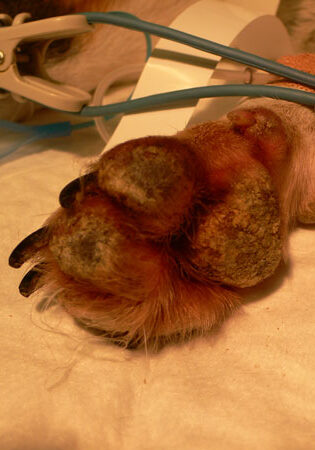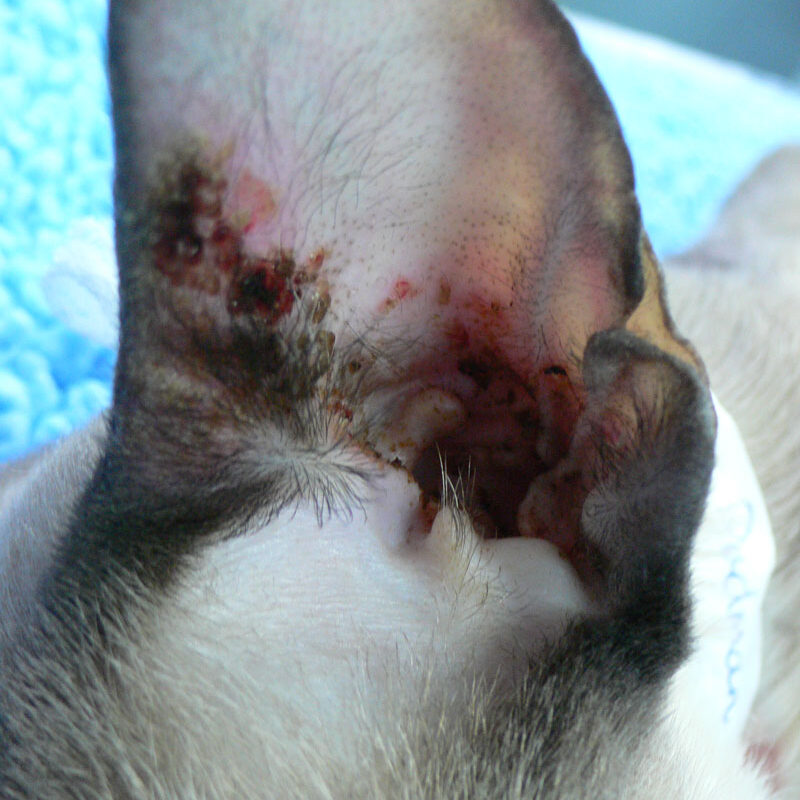Why Should I Bring my Pet to Willows?
Willows is one of Europe’s leading small animal referral centres. Our state-of-the-art hospital is led by internationally renowned Specialists who are committed to providing the highest standards of veterinary care.
The Dermatology service at Willows is led by Dr Richard Harvey BVSc DVD DipECVD PhD FRSB FRCVS, who has successfully diagnosed and treated many dogs with pemphigus foliaceus.
What is Pemphigus?
Pemphigus is a disease of dogs, cats, horses and goats and is a type of autoimmune skin disease. These diseases result when the immune system functions abnormally, targeting normal cells and structures of the body. In the case of pemphigus, the immune system targets the ‘links’ between the cells of the skin resulting in blisters, pus-filled spots and crusting. There are two main types of pemphigus in domestic animals. Pemphigus vulgaris is a very rare disease and results in deep and painful lesions which can be life threatening. Pemphigus foliaceus (PF) is also rare, but is reportedly the most common autoimmune skin disease in dogs. Pemphigus foliaceus causes more superficial skin lesions and is not normally as severe as pemphigus vulgaris.
What Causes Pemphigus Foliaceus?
Pemphigus foliaceus usually develops due to unknown reasons, although some cases have been linked to drug reactions. It is therefore vital to establish whether any drugs were being used in the months leading up to the development of lesions. Some cases of PF have also been linked to chronic skin disease, as some dogs with a long history of allergic skin disease have gone on to develop PF. In dogs, Akitas and Chow chows appear to be particularly at risk of this disease, suggesting that genetics might also have a part to play.

How is Pemphigus Foliaceus Diagnosed?
Close examination of the skin can provide important clues. In dogs, PF causes ‘pustular’ lesions. These are pus-filled spots that usually develop into scabs and sores and are very commonly found on the face, head and ears. Some cases have been described just affecting the footpads (Fig 1.), but in more severe cases, the whole body can be affected.
The head, face and ears are also commonly involved in PF in cats (Fig 2). Interestingly, cats also commonly suffer from involvement of the claws, and this can sometimes be the most obvious sign. As with dogs, severe cases tend to involve most of the body.
Most cats and dogs remain systemically well, although they can be more lethargic and show a reduced appetite
The diagnosis of PF can be confirmed with a biopsy of affected skin. If lesions are present around the face and head, this procedure is usually carried out under general anaesthesia so that the animal remains perfectly still. Only very small biopsies of the skin are needed, and the cosmetic outcome is usually very good. The biopsied skin is sent away for analysis at a laboratory where the pathologist can see if the intercellular ‘links’ have been disrupted within the skin.
Fig 1: Crusting of the footpads in a dog with pemphigus foliaceus


What Treatments are Available for Pemphigus Foliaceus?
As PF develops due to an ‘overactive’ immune system, treatment aims to reduce the immune attack of the cells of the skin. Steroid medication is the cornerstone of treatment in both dogs and cats, and relatively high doses are usually required initially to control the disease. In most cases, the doses of steroids are then be reduced carefully down to a level that controls the disease, but minimises long term side effects. In some cases, other drugs such as azathioprine, chlorambucil and ciclosporin have to be used or added in order to achieve control of the disease. If a drug trigger is suspected, it is also vital to remove this as part of the treatment.
Fig 2: Crusting around the ear of a young cat with pemphigus foliaceus
What Can I Expect if my Pet has been Diagnosed with Pemphigus Foliaceus?
PF can usually be controlled quite well, with many dogs and cats remaining free of disease with the use of long term medication. In the vast of majority of cases, medication will be required in some form for the rest of the animal’s life.
To save this page as a PDF, click the button and make sure “Save as PDF” is selected.
Skin and Ear Clinic
Find out more
To assist owners whose pets have skin and ear conditions, we have put together a range of information pages to talk you through some of the more common dermatology conditions seen by our Specialist team.

